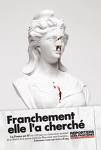
May 68
The cinema quickly became a very important weapon in the service of the struggle. The women grabbed the camera to allow the women without a voiceto express theirselves. By assuming their representation, they assumed their liberation. The idea was that the control of the image of their body would lead to the control of their body. The feminist cinema of May 68 was of course militant, shot in the middle of the action, on the fringe of the production and distribution systems. Cinema was, at this time, almost exclusively for men. That is why women shot all their short-movies in Super-8 or Video, and these little cameras were the best tools for this kind of militant action, thanks to the technological innovations : they could watch their images immediately, the cameras were less heavy, the shots could last 30 seconds. The video allowed the filmmakers to be quick and reactive.
Their movies rejected the language of the dominant cinema, reproducing the dominant ideology. They gave women the right to talk : for instance, Carole Roussopoulos interviewed a female manual laborer in Monique Lip 1 , and she talks about her life during the strike.
A movie synthetizes all the feminist questions : Sorcières Camarades by Danielle Jaeggi in 1971. It symbolizes the birth of a “We, women”, from the individual to the collective. This movie links politics to aesthetics. You can see an extract on http://www.lepeuplequimanque.org/distribution-2?brand=9 : it is the beginnig of the movie.
A movie synthetizes all the feminist questions : Sorcières Camarades by Danielle Jaeggi in 1971. It symbolizes the birth of a “We, women”, from the individual to the collective. This movie links politics to aesthetics. You can see an extract on http://www.lepeuplequimanque.org/distribution-2?brand=9 : it is the beginnig of the movie.
These militant movies were often about abortion. One was particularly direct. Y a qu’à pas baiser, by Carole Roussopoulos, shows images of an abortion in 1971 : the camera was really between the legs of a woman. It was of course censored (as many feminist movies were) and was projected in illegal theaters.

